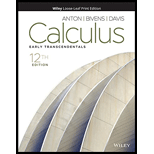
(a) What is the difference between a vector and a scalar? Give a physical example of each.
(b) How can you determine whether or not two
(c) How can you determine whether or not two vectors are parallel?
(d) How can you determine whether or not three vectors with a common initial point lie in the same plane in 3-space?
(a)
The difference between a vector and a scalar by giving a physical example.
Answer to Problem 1RE
A scalar quantity is the quantity that has only magnitude and vector quantity is the quantity that has magnitude as well as direction.
Explanation of Solution
Scalar: A scalar quantity is the quantity that has only magnitude.
For example: time, speed, temperature, and volume.
Vector: A vector quantity is the quantity that has magnitude as well as direction.
For example: displacement, velocity, acceleration, and force.
(b)
Whether the two vectors are orthogonal or not.
Answer to Problem 1RE
The vectors,
Explanation of Solution
The two vectors are orthogonal if and only if their dot product is zero.
Therefore, the vectors,
(c)
Whether the two vectors are parallel or not.
Answer to Problem 1RE
The vectors,
Explanation of Solution
The two vectors are parallel if and only if their cross product is a zero vector.
Therefore, the vectors,
(d)
Whether or not the three vectors with a common initial point lie in the same plane in the 3-space.
Answer to Problem 1RE
The vectors,
Explanation of Solution
Given Information:
The three vectors with a common initial point lie in the same plane in the 3-space.
Three vectors with a common initial point lie in a plane if and only if their scalar triple product is zero.
Therefore, the vectors,
Want to see more full solutions like this?
Chapter 11 Solutions
Calculus: Early Transcendentals, Enhanced Etext
Additional Math Textbook Solutions
University Calculus: Early Transcendentals (4th Edition)
Elementary Statistics (13th Edition)
Introductory Statistics
Elementary Statistics
Algebra and Trigonometry (6th Edition)
Thinking Mathematically (6th Edition)
- 1. For each of the following, find the critical numbers of f, the intervals on which f is increasing or decreasing, and the relative maximum and minimum values of f. (a) f(x) = x² - 2x²+3 (b) f(x) = (x+1)5-5x-2 (c) f(x) = x2 x-9 2. For each of the following, find the intervals on which f is concave upward or downward and the inflection points of f. (a) f(x) = x - 2x²+3 (b) g(x) = x³- x (c) f(x)=x-6x3 + x-8 3. Find the relative maximum and minimum values of the following functions by using the Second Derivative Test. (a) f(x)=1+3x² - 2x3 (b) g(x) = 2x3 + 3x² - 12x-4arrow_forwardFind the Soultion to the following dy differential equation using Fourier in transforms: = , хуо, ухо according to the terms: lim u(x,y) = 0 x18 lim 4x (x,y) = 0 x14 2 u (x, 0) = =\u(o,y) = -y لوarrow_forwardCan you solve question 3,4,5 and 6 for this questionarrow_forward
- water at a rate of 2 m³/min. of the water height in this tank? 16) A box with a square base and an open top must have a volume of 256 cubic inches. Find the dimensions of the box that will minimize the amount of material used (the surface area). 17) A farmer wishes toarrow_forward#14 Sand pours from a chute and forms a conical pile whose height is always equal to its base diameter. The height o the pile increases at a rate of 5 feet/hour. Find the rate of change of the volume of the sand in the conical pile when the height of the pile is 4 feet.arrow_forward(d)(65in(x)-5 cos(x) dx mins by 5x-2x² 3x+1 dx -dx 20 Evaluate each the following indefinite integralsarrow_forward
- 19 Evaluate each the following definite integrals: a) લ b) (+3) 6) (2-2)(+33) dxarrow_forward#11 If a snowball melts so its surface area decreases at a rate of 1cm²/min, find the rate at which the diameter decreases when the diameter is 6 cm.arrow_forwardUse Deritivitve of the inverse to solve thisarrow_forward
- Evaluate the following Limits: e6x-1 Lim +0Sin3x 7x-5x2 2x-1+ Cos 4x +6 c) Lim b) Lim + x³-x2 X-0 1-e' 4x d) Lim 6x²-3 X+0 6x+2x² Find the derivatives of the following functions using the Limit definition of derivativearrow_forward15A cylindrical tank with radius 8 m is being filled with water at a rate of 2 m³/min. What is the rate of change of the water height in this tank? 6)A box with a square base and an open top must box that will minimiarrow_forward#12 The radius of a sphere increases at a rate of 3 in/sec. How fast is the volume increasing when the diameter is 24arrow_forward
- Algebra & Trigonometry with Analytic GeometryAlgebraISBN:9781133382119Author:SwokowskiPublisher:Cengage
 Trigonometry (MindTap Course List)TrigonometryISBN:9781337278461Author:Ron LarsonPublisher:Cengage Learning
Trigonometry (MindTap Course List)TrigonometryISBN:9781337278461Author:Ron LarsonPublisher:Cengage Learning Elementary Linear Algebra (MindTap Course List)AlgebraISBN:9781305658004Author:Ron LarsonPublisher:Cengage Learning
Elementary Linear Algebra (MindTap Course List)AlgebraISBN:9781305658004Author:Ron LarsonPublisher:Cengage Learning  Algebra and Trigonometry (MindTap Course List)AlgebraISBN:9781305071742Author:James Stewart, Lothar Redlin, Saleem WatsonPublisher:Cengage Learning
Algebra and Trigonometry (MindTap Course List)AlgebraISBN:9781305071742Author:James Stewart, Lothar Redlin, Saleem WatsonPublisher:Cengage Learning



